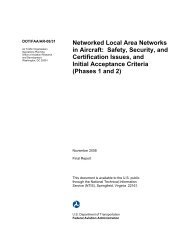Published Report (DOT/FAA/CT-94-36)
Published Report (DOT/FAA/CT-94-36)
Published Report (DOT/FAA/CT-94-36)
You also want an ePaper? Increase the reach of your titles
YUMPU automatically turns print PDFs into web optimized ePapers that Google loves.
TABLE 8. TCV DATA, TWA621/AAL204<br />
Blundering Aircraft Evading Aircraft<br />
11<br />
II<br />
11<br />
Runway 17L 17R<br />
I<br />
I<br />
I<br />
Call Sign<br />
TWA621<br />
AAL204<br />
Groundspeed at<br />
Blunder Start (kn)<br />
Altitude at<br />
Blunder Start (ft)<br />
CPA (ft)<br />
200 184<br />
8307 8457<br />
301 at 7.9 nmi from runway threshold<br />
The pilot of the evading aircraft was flying by hand (i-e., raw<br />
data) at the time of the blunder. The site coordinator log<br />
indicated a llnormalll breakout maneuver with a maximum observed<br />
bank angle of 30 degrees. The site coordinator noted that the<br />
initial ATC instruction was a turn to 270 and a climb to 11,000.<br />
A second heading of 320 was later given.<br />
Table 9 is a record of the dialogue between the controllers and<br />
pilots during the conflict. Transmission times were extracted<br />
from the video tape of the run and reflect real-time minutes and<br />
seconds of the simulation clock.<br />
One technical observer attributed the TCV to slow pilot and<br />
aircraft response. The observer wrote, VWA 621, NORDO. 17R<br />
pilot slow to turn."<br />
The controller for the 17R runway (i.e., evading aircraft runway)<br />
wrote that the blunder was self-identified. He noted that he saw<br />
the blundering aircraft right of the 17L localizer, but not in<br />
the NTZ. The controller stated that he immediately turned and<br />
climbed AAL204, before TWA621 entered the NTZ. The controller<br />
identified pilot action and a slow aircraft turn as the causal<br />
factors in the conflict. The controller also wrote that, Vwo<br />
factors contributed to the conflict: 1) speed overtake -<br />
blundering aircraft was flying 20 kn faster than the evading<br />
aircraft, and 2) the evading aircraft was slow in turning and<br />
climbing.11 It was recommended that to prevent a recurrence of<br />
this type of conflict, the evading aircraft should use a faster<br />
turn rate.<br />
The controller for the blundering aircraft runway (i.e., 17L)<br />
noted that he self-identified the blunder when TWA621 deviated<br />
from course. The controller attempted to turn TWA621, but he did<br />
not get a response. The controller also identified pilot action<br />
29

















